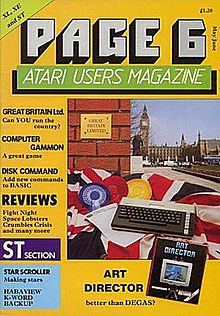Page 6
 May/June 1987 issue | |
| Editor | Les Ellingham |
|---|---|
| Categories | Atari 8-bit Atari ST |
| Frequency | Bi-monthly |
| Publisher | Page 6 Publishing |
| Year founded | 1982 |
| Final issue | 1998 |
| Based in | Stafford |
| Language | English |
| ISSN | 0952-4967 |
Page 6 (subtitled Atari Users Magazine and later known as Page 6 Atari User, then New Atari User) was an independent British publication aimed at users of Atari home computers. It was published between 1982 and 1998. The magazine supported both the Atari 8-bit family and later the Atari ST models.
History[]
The magazine had its origins in the newsletter of the Birmingham User's Group, an independent Atari club based in England. Les Ellingham was appointed to be the editor of the newsletter, but decided to produce a magazine with broader appeal instead. He remained editor of Page 6 throughout its entire run of 85 issues. Although subscription-only for most of its life, it was available through newsagents during the late 1980s and early 1990s.
When Database ceased publication of the original Atari User magazine in 1988, Page 6 bought the rights (and subscriber list),[1] and renamed their magazine, firstly to Page 6 Atari User in February 1989[1][2] and then to New Atari User in June of the same year.[3] The latter was simply Page 6 under a different (and more newsagent-friendly) name,[3] and had next to no continuity with the original Atari User. The editor Les Ellingham had declined the offer to edit the original Atari User when approached by Database Publications in 1985.
Due to "high interest rate, reluctance of the news trade to support smaller circulation magazines and reducing advertising income", New Atari User had to be withdrawn from retail sales and become subscription-only with issue 59 (December-January 1993).[4][5]
The title[]
The magazine was named after the area of memory in 8-bit Atari computers covering locations 1536–1791 (or $600–$6FF, where the "$" prefix indicates hexadecimal notation). Memory is divided into "pages" of 256 bytes (the first being page 0), making locations 1536 (256×6) to 1791 be "page 6." Page 6 memory is neither used by the operating system nor by Atari BASIC programs and so can be used to store the short machine code routines without them being overwritten.
References[]
- ^ a b "Stop Press". Page 6 (35): 5. December 1988.
Literally in the last couple of days before this issue went to press PAGE 6 completed discussions with Database Publications which resulted in an agreement for PAGE 6 to take over the Atari User title [..] Look out for the new PAGE 6 ATARI USER on sale 19th JANUARY
- ^ "Editorial: Ringing the Changes?". Page 6 Atari User (36): 4. February 1989.
This issue I have to welcome a lot of new readers to PAGE 6 ATARI USER [..] The major change that you will notice is a change in the name of the magazine
- ^ a b Les Ellingham (June 1989). "For Better or Worse". New Atari User (38).
So here we have the first issue of NEW ATARI USER or rather the 38th issue of PAGE 6! [..] those who have been with us a long while can still call us PAGE 6 [..] nothing's changed except the name on the front cover.
- ^ Page 6 (58): 4. October 1992.
{{cite journal}}: Missing or empty|title=(help) - ^ Page 6 (59): 4. December 1992.
{{cite journal}}: Missing or empty|title=(help)
External links[]
- Officially authorised Page 6/New Atari User website
- The Page 6 Magazine Library at the Centre for Computing History
- 1982 establishments in the United Kingdom
- 1998 disestablishments in the United Kingdom
- Atari 8-bit computer magazines
- Atari ST magazines
- Bi-monthly magazines published in the United Kingdom
- Video game magazines published in the United Kingdom
- Defunct computer magazines published in the United Kingdom
- Home computer magazines
- Magazines established in 1982
- Magazines disestablished in 1998
- Mass media in Birmingham, West Midlands
- Mass media in Staffordshire
- Computer magazines published in the United Kingdom stubs